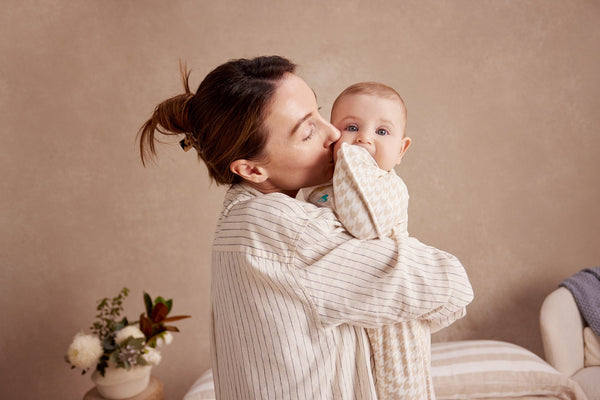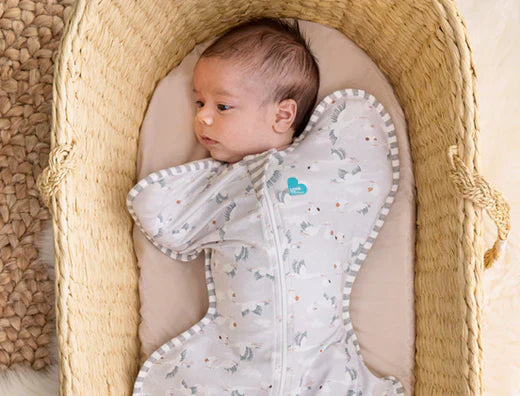Why is my baby not settling?
From hunger to discomfort, find the common reasons why your child isn’t settling below.
Your baby needs feeding
When your child is struggling to settle, think about where they are in their sleep-feed-uptime cycle.
Always make sure to feed your baby before putting them down to sleep. This will help to settle them and increase the time before they wake for another feed.
Your baby needs burping
Your baby might be struggling to settle because they need to be burped. Common signs that they need to burp are squirming, pained facial expressions, crying or fussing, arching their back, and clenching their fists.
Find tips on how to burp your baby below.
- Pat them on the back using a cupped hand (this is gentler than a flat palm).
- Drape a towel or bib over your shoulder/lap to protect your clothing in case your baby spits up.
Your baby needs changing
Always make sure your baby has been changed and that you have treated nappy rash before putting them down for a nap.
Your baby is overtired
When your child is struggling to settle, think about where they are in their sleep-feed-uptime cycle.
If your baby is struggling to fall asleep, they might be overtired. Below, find common signs of overtiredness:
- Pulling at their ears.
- Closing their fists.
- Yawning.
- Sucking on their fingers (this is also a sign of self-soothing).
- Frowning.
- Fluttering their eyelids.
- Staring into space or looking confused.
Your baby is too cold or too hot
You can monitor your child’s temperature by feeling their back or tummy, which should be warm. Choose their sleepwear based on the season and temperature. You can use our clothing guide to find the right sleepwear and swaddle for your baby.
Never use blankets, hot water bottles, or heated blankets. Always follow safe sleep guidelines.
Your child needs physical assistance
From birth to three months old, most children need physical or emotional assistance from a parent/caregiver to fall back to sleep. Rocking, feeding, holding, or offering a pacifier are common ways to achieve this.
Your baby is unwell
If you have followed the above steps and your child is still struggling to settle, it’s important to ensure that they are not unwell. Check to see if they have a temperature and consider whether they’re teething. A cold, infection, or upset stomach are common reasons why your baby won’t settle.
If you have concerns about your child’s health, contact a medical professional immediately.
Baby settling techniques
From swaddling to using white noise, discover common settling techniques below.
Swaddling
Our award-winning Swaddle Up™ is designed to encourage your little one to safely self-soothe. Its unique wing tips mean your child can sleep in a more natural arms-up™ position while the twin zipper enables easy nappy changes without disturbing sleep.
Once your child start to show signs of rolling over or pulling up onto their hands, you must stop swaddling. Designed to help your little one slowly graduate to arms-free sleep, our Ready To Roll collection features Transition Suits and Bags™ with wings that can be removed one by one.
Rocking your baby
Some babies require physical and emotional assistance to settle and sleep. You might find that rocking your baby helps to calm them down.
Short car journey
Some parents and caregivers find that taking their baby on a short car journey helps to settle them. Always follow health and safety guidelines.
White noise
Parents and caregivers often use a white noise machine or app to help their child to settle and sleep better. It is designed to recreate the feeling of being in the womb and will block out other distracting noises such as older siblings, the television, or traffic outside.
If you are using white noise, always follow the below safety advice:
- Always turn the white noise machine off or turn the volume down if your child is distressed.
- Always keep the white noise machine at least two metres away from your baby’s cot.
- Ensure the sound level never exceeds 50 decibels (no louder than a quiet conversation or a shower running). This may be the lowest setting on your machine.
- Always make sure the white noise machine is out of your child’s reach and any cords are safely tucked away.
- Always follow the manufacturer’s directions and safety warnings.
- Turn the white noise machine off when your child is asleep.
What should I do if my baby still won’t settle?
Every child is different, and it might take time to find what works for your child. Following an evening routine will help your little one to understand when it’s time to sleep. This might look like a bath, reading a book, or baby massage.
It’s also important to create a calming sleep space for your baby. Turn down the lights, close the blinds/curtains, and keep the noise down. Speak in hushed tones and use white noise if this is something your child responds well to. Always follow safe sleep guidelines.







